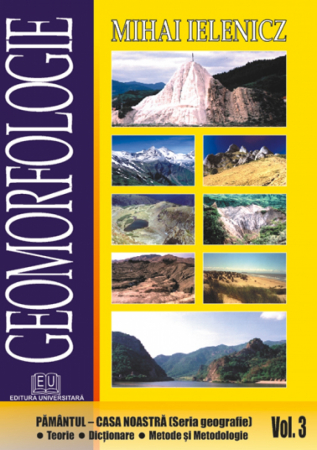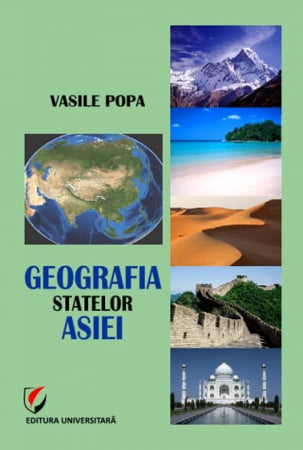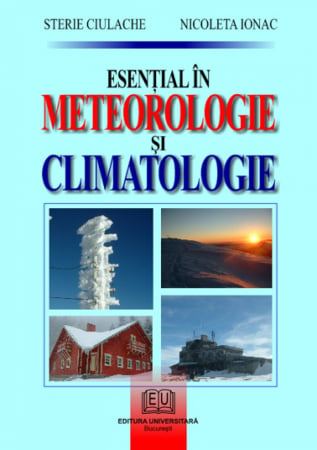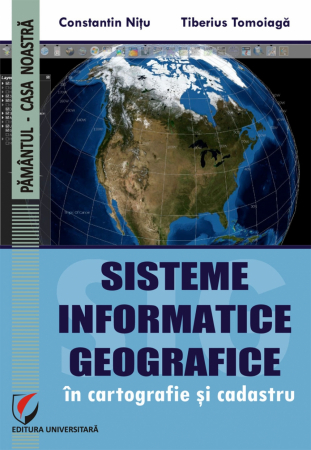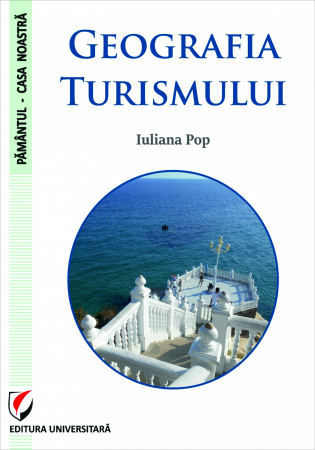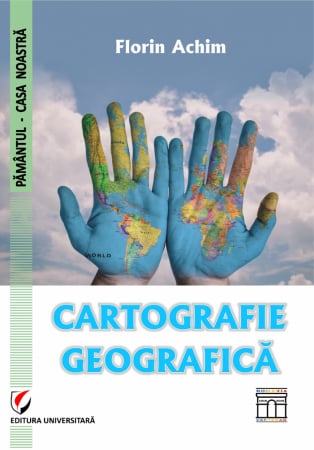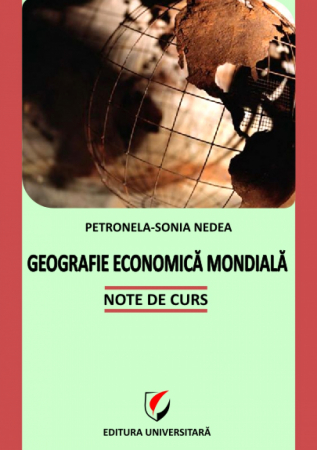Manuscript proposals: info@editurauniversitara.ro / 0745 204 115 //// Tracking orders Individuals / Sales:0745 200 718 / 0745 200 357 Orders Legal entities: 0721 722 783
ISBN: 978-606-591-309-7
DOI: 10.5682/9786065913097
Publisher year: 2011
Edition: I
Pages: 264
Publisher: Editura Universitara
Author: Mihai Ielenicz, Mioara Clius (Ghincea), Ileana Georgeta Pătru-Stupariu
Product Code:
9786065913097
Do you need help?
0745 200 718
/
0745 200 357
- Description
- Download (1)
- Authors
- Content
- More details
- Where to find it
- Reviews (0)
In this paper, the authors have proposed several directions that will lead to a better understanding of this great geographical unit. Among these we mention: the brief knowledge of all the elements that compose the system, but with details in the problems that needed more explanations (some not existing in other synthesis works); genetic-evolutionary correlations that ensure the understanding of processes and results as well as the unity and specificity of the Subcarpathians; highlighting some results (ideas and illustrative materials) from the research of many existing geographers only at the level of some articles or doctoral theses; a bibliography that should include as much data as possible from the information fund regarding this space.
At the same time, we wanted to offer some of the ideas and conclusions we reached and which are based on data from our own observations made in many places in the Subcarpathians, but also on the interpretation of geological and geographical materials that have seen the light of day over the years.
We consider that through the way of dealing with the problems, through the degree of deepening and illustration, this paper responds to the requirements of knowing a large number of readers. It is addressed primarily to students, not only geographers, teachers of pre-university education in current training but also for final, second degree and tenure and all those who want to know and take into account the characteristics of the Subcarpathians.
At the same time, we wanted to offer some of the ideas and conclusions we reached and which are based on data from our own observations made in many places in the Subcarpathians, but also on the interpretation of geological and geographical materials that have seen the light of day over the years.
We consider that through the way of dealing with the problems, through the degree of deepening and illustration, this paper responds to the requirements of knowing a large number of readers. It is addressed primarily to students, not only geographers, teachers of pre-university education in current training but also for final, second degree and tenure and all those who want to know and take into account the characteristics of the Subcarpathians.
-
Romania. Subcarpatii. Volumul 4
Download
MIHAI IELENICZ
Prof. univ. dr., graduated from the Faculty of Geology-Geography in 1964 where he continued his activity going through all the steps of the university hierarchy. Doctor in Geography since 1978 with the work "Mountains from the Buzau basin - study of geomorphology", published in the Academy Publishing House in 1984. He won the Academy Award in 1975 for the work "Relief of Romania" and in 1985 for the work "Encyclopedia of Romania", as well as the title of Doctor Honoris Causa of Stefan cel Mare University - Suceava; He has been awarded over 25 honorary diplomas, excellence and medals by various teaching and scientific institutions in the country and abroad. Vice-Dean and Dean of the Faculty of Geography since 1992 and until now, Director of the Geographical Resort Orsova, Co-director of the "Center for Research on Land Degradation and Geomorphological Dynamics" Member of the Faculty Council and University Senate since 1992, Chairman of the Committee National Program for Pre-University Education (since 1996), CNATDC member, CNEAA, CNCSIS expert, training in the country and abroad (UK, Belgium, Turkey), President of the Geography School Olympics (since 1996), President of the Geography Society ( since 2003), Vice President of the National Geography Committee (since 2000), Vice President of the Geomorphology Association (since 2002), PhD supervisor (since 1993), member of the editorial boards of numerous specialized journals, etc. He wrote alone and in collaboration over 210 scientific papers, participated in 62 research contracts (18 as director), 38 scientific books: "General Geomorphology" 1976, 2002, "Relief of Romania" 1975, "Hills and Plateau of Romania ”1999,„ Dictionar fizico-geografic ”1999,„ Geografia generala ”2001,„ Romania Geography and Tourism ”2001,„ Europa Enciclopedie Geografica ”2002,„ Subcarpatii Romaniei ”2003,„ Romania - Geografie Fizica ”2004,“ Geografie fizica generala . The bases of physical geography ”2005“ Subcarpathians of Romania ”2005,“ Geomorphology ”2007, 2010,“ Romania. Physical geography. Climate, Waters, Vegetation, Soils ”2007,“ Romania. Plateau and hills ”2008,“ Dictionary of geomorphology ”2009,“ General physical geography with elements of cosmology ”2009,“ Romania - Tourist potential ”2009, and numerous popularization books, maps, etc.
MIOARA CLIUS (GHINCEA)
University lecturer PhD, graduated from the Faculty of Geography of the University of Bucharest in 1995, specializing in Geomorphology-Pedology, as well as the postgraduate course for the in-depth study of "Sustainable management of geographical landscapes through regional organization and planning."
He elaborated and published alone or in collaboration courses, practical workbooks, specialized articles, etc.
He has participated in training courses in the country and abroad, in symposia, scientific sessions and debate circles.
ILEANA GEORGETA PATRU-STUPARIU
Prof. univ. PhD, graduated from the Faculty of Geography of the University of Bucharest in 1993, completing all teaching degrees up to university professor; in the period 2004-2008 he was Dean of the Faculty of Geography.
He obtained his PhD in geographic sciences in 1999 with the work "Bran-Rucar Transcarpathian Corridor, study of physical geography and landscape assessment", published by the University Publishing House, 2001. He is responsible coordinator of the Socrates - Erasmus Program and member of the Geography Society at AUF and M.E.C. scholarship evaluator.
She elaborated and published alone or in collaboration books, dictionaries, maps, specialized articles. He also participated in several symposia and scientific sessions, training and teaching abroad (Belgium, Spain, Italy, France). He is currently the head of the Department of Regional Geography.
Prof. univ. dr., graduated from the Faculty of Geology-Geography in 1964 where he continued his activity going through all the steps of the university hierarchy. Doctor in Geography since 1978 with the work "Mountains from the Buzau basin - study of geomorphology", published in the Academy Publishing House in 1984. He won the Academy Award in 1975 for the work "Relief of Romania" and in 1985 for the work "Encyclopedia of Romania", as well as the title of Doctor Honoris Causa of Stefan cel Mare University - Suceava; He has been awarded over 25 honorary diplomas, excellence and medals by various teaching and scientific institutions in the country and abroad. Vice-Dean and Dean of the Faculty of Geography since 1992 and until now, Director of the Geographical Resort Orsova, Co-director of the "Center for Research on Land Degradation and Geomorphological Dynamics" Member of the Faculty Council and University Senate since 1992, Chairman of the Committee National Program for Pre-University Education (since 1996), CNATDC member, CNEAA, CNCSIS expert, training in the country and abroad (UK, Belgium, Turkey), President of the Geography School Olympics (since 1996), President of the Geography Society ( since 2003), Vice President of the National Geography Committee (since 2000), Vice President of the Geomorphology Association (since 2002), PhD supervisor (since 1993), member of the editorial boards of numerous specialized journals, etc. He wrote alone and in collaboration over 210 scientific papers, participated in 62 research contracts (18 as director), 38 scientific books: "General Geomorphology" 1976, 2002, "Relief of Romania" 1975, "Hills and Plateau of Romania ”1999,„ Dictionar fizico-geografic ”1999,„ Geografia generala ”2001,„ Romania Geography and Tourism ”2001,„ Europa Enciclopedie Geografica ”2002,„ Subcarpatii Romaniei ”2003,„ Romania - Geografie Fizica ”2004,“ Geografie fizica generala . The bases of physical geography ”2005“ Subcarpathians of Romania ”2005,“ Geomorphology ”2007, 2010,“ Romania. Physical geography. Climate, Waters, Vegetation, Soils ”2007,“ Romania. Plateau and hills ”2008,“ Dictionary of geomorphology ”2009,“ General physical geography with elements of cosmology ”2009,“ Romania - Tourist potential ”2009, and numerous popularization books, maps, etc.
MIOARA CLIUS (GHINCEA)
University lecturer PhD, graduated from the Faculty of Geography of the University of Bucharest in 1995, specializing in Geomorphology-Pedology, as well as the postgraduate course for the in-depth study of "Sustainable management of geographical landscapes through regional organization and planning."
He elaborated and published alone or in collaboration courses, practical workbooks, specialized articles, etc.
He has participated in training courses in the country and abroad, in symposia, scientific sessions and debate circles.
ILEANA GEORGETA PATRU-STUPARIU
Prof. univ. PhD, graduated from the Faculty of Geography of the University of Bucharest in 1993, completing all teaching degrees up to university professor; in the period 2004-2008 he was Dean of the Faculty of Geography.
He obtained his PhD in geographic sciences in 1999 with the work "Bran-Rucar Transcarpathian Corridor, study of physical geography and landscape assessment", published by the University Publishing House, 2001. He is responsible coordinator of the Socrates - Erasmus Program and member of the Geography Society at AUF and M.E.C. scholarship evaluator.
She elaborated and published alone or in collaboration books, dictionaries, maps, specialized articles. He also participated in several symposia and scientific sessions, training and teaching abroad (Belgium, Spain, Italy, France). He is currently the head of the Department of Regional Geography.
Foreword / 3
Contents / 5
Chapter I / 7
GENERAL DATA / 7
Geographical position, surface, development / 7
Name of Subcarpathians / 7
Subcarpathian boundaries of the Carpathians, plains or other hill and plateau units / 12
Chapter II / 21
HISTORY OF KNOWLEDGE / 21
Chapter III / 23
GEOLOGY OF THE SUBCARPATIC REGION / 23
Getica Depression / 23
The foundation / 23
Sedimentary superstructure / 23
Pericarpatic depression / 25
The foundation / 25
Sedimentary deposits / 26
Chapter IV / 28
RELIEF / 28
General characteristics / 28
Morphometric and morphographic elements / 29
Surfaces and erosion levels / 31
Terraces / 36
Meadows / 45
Structural relief / 49
Petrographic relief / 53
Current modeling systems and the impact of their manifestation on the landscape / 57
Favoring factors / 57
Slope morphogenetic systems / 61
Riverbed morphogenetic systems / 71
Formation and evolution of the hydrographic network / 72
Chapter V / 83
CLIMATE / 83
Genetic factors / 83
Solar radiation / 83
Air mass circulation / 84
Regional geographical factors / 84
Thermal potential / 86
Nebulae / 92
Precipitation regime / 92
The winds / 94
Characteristic meteorological phenomena / 94
Climatic differences / 96
Chapter VI / 98
WATERS / 98
Groundwater / 98
Groundwater / 98
Deep waters / 99
Hydrographic network / 100
Morphohydrographic characteristics / 100
Hydrological characteristics / 101
The lakes / 108
Chapter VII / 110
VEGETATION, FAUNA, SOILS AND NATURAL RESERVATIONS / 110
Vegetable cover / 110
Factors that determine the distribution and composition of vegetation / 111
Geographical distribution of vegetation / 116
Fauna / 123
Soils / 124
Natural pedogenetic factors / 124
The main types of soils / 125
Intrazonal soils / 127
Degrees of anthropization of the geographical landscape and environmental protection / 128
Chapter VIII / 138
POPULATION AND SETTLEMENTS / 138
Data of historical geography / 138
Demographic characteristics / 140
Structure by age groups / 142
Population density / 142
Settlements / 144
Urban settlements / 146
Rural settlements / 146
Chapter IX / 150
ECONOMY / 150
General characteristics / 150
Industry / 153
Energy industry / 154
Machine building industry / 157
Chemical industry / 158
Construction materials industry / 158
Lem exploitation and processing industry / 158
Light industry / 159
Food industry / 159
Agriculture / 160
Land use / 161
Agricultural crops / 163
Ways of communication / 166
Road network / 166
Railway network / 167
Tourist potential / 167
Chapter X / 172
REGIONAL UNITS / 172
SUBCARPATHIES OF MOLDOVA / 172
Development, limits / 172
The natural setting / 173
Population, settlements, economy / 182
CURVED SUBCARPATHIES / 188
Development and limits / 188
The natural setting / 190
Population, settlements, economy / 204
GETIC SUBCARPATHIES / 210
Development and limits / 210
The natural setting / 211
Population, settlements, economy / 220
Bibliography / 229
Contents / 5
Chapter I / 7
GENERAL DATA / 7
Geographical position, surface, development / 7
Name of Subcarpathians / 7
Subcarpathian boundaries of the Carpathians, plains or other hill and plateau units / 12
Chapter II / 21
HISTORY OF KNOWLEDGE / 21
Chapter III / 23
GEOLOGY OF THE SUBCARPATIC REGION / 23
Getica Depression / 23
The foundation / 23
Sedimentary superstructure / 23
Pericarpatic depression / 25
The foundation / 25
Sedimentary deposits / 26
Chapter IV / 28
RELIEF / 28
General characteristics / 28
Morphometric and morphographic elements / 29
Surfaces and erosion levels / 31
Terraces / 36
Meadows / 45
Structural relief / 49
Petrographic relief / 53
Current modeling systems and the impact of their manifestation on the landscape / 57
Favoring factors / 57
Slope morphogenetic systems / 61
Riverbed morphogenetic systems / 71
Formation and evolution of the hydrographic network / 72
Chapter V / 83
CLIMATE / 83
Genetic factors / 83
Solar radiation / 83
Air mass circulation / 84
Regional geographical factors / 84
Thermal potential / 86
Nebulae / 92
Precipitation regime / 92
The winds / 94
Characteristic meteorological phenomena / 94
Climatic differences / 96
Chapter VI / 98
WATERS / 98
Groundwater / 98
Groundwater / 98
Deep waters / 99
Hydrographic network / 100
Morphohydrographic characteristics / 100
Hydrological characteristics / 101
The lakes / 108
Chapter VII / 110
VEGETATION, FAUNA, SOILS AND NATURAL RESERVATIONS / 110
Vegetable cover / 110
Factors that determine the distribution and composition of vegetation / 111
Geographical distribution of vegetation / 116
Fauna / 123
Soils / 124
Natural pedogenetic factors / 124
The main types of soils / 125
Intrazonal soils / 127
Degrees of anthropization of the geographical landscape and environmental protection / 128
Chapter VIII / 138
POPULATION AND SETTLEMENTS / 138
Data of historical geography / 138
Demographic characteristics / 140
Structure by age groups / 142
Population density / 142
Settlements / 144
Urban settlements / 146
Rural settlements / 146
Chapter IX / 150
ECONOMY / 150
General characteristics / 150
Industry / 153
Energy industry / 154
Machine building industry / 157
Chemical industry / 158
Construction materials industry / 158
Lem exploitation and processing industry / 158
Light industry / 159
Food industry / 159
Agriculture / 160
Land use / 161
Agricultural crops / 163
Ways of communication / 166
Road network / 166
Railway network / 167
Tourist potential / 167
Chapter X / 172
REGIONAL UNITS / 172
SUBCARPATHIES OF MOLDOVA / 172
Development, limits / 172
The natural setting / 173
Population, settlements, economy / 182
CURVED SUBCARPATHIES / 188
Development and limits / 188
The natural setting / 190
Population, settlements, economy / 204
GETIC SUBCARPATHIES / 210
Development and limits / 210
The natural setting / 211
Population, settlements, economy / 220
Bibliography / 229
The Subcarpathians constitute by physiognomy, structure, genesis, evolution, resources, ways of exercising the increasingly diverse activities of man, etc., an extremely complex region whose knowledge involved in-depth analyzes that required numerous studies that exceeded its limits. Their very identification in the system of Romanian geographical units has aroused over the years not only interest but also disputes that started from the name (they were also called Pericarpati or Precarpati) and continued with belonging to the great surrounding orographic stages, mountains or hills. , with which they had many common features. The first, the Subcarpathians are connected by genesis, composition, structural elements, evolution and sometimes by height or morphometric features. From the hills, the Subcarpathians are approached by the overall appearance (rounded peaks separated by depressions and valley color covered by a blanket of soils and common plant formations), by favorable conditions for a popular ancient that led on the one hand to the development of a multitude of settlements that climbed from the hearth of the depressions on the slopes and sometimes to the wider bridges of the interfluves, and on the other hand to the individualization of the most varied ways of land use (from cereals, technical plants, vineyards and orchards to pastures, meadows and forests for oil and mining operations, etc.).
Hence, the belief of both geologists and geographers to place them in the Carpathians - as the youngest unit in the process of evolution, but also the conviction of many geographers to associate them with the hills. Equally important is the opinion of a third category of specialists who, based on the reflection in the landscape of the links between the multitude of factors that worked evolutionarily and spatially in drawing this geographical system, consider them as a unit of interference between the two types. So we can say, without mistake, that the Subcarpathians living in a Carpathian area have gradually acquired the features of hills through an evolution imposed by external agents between which man had a special place. So, if through the internal characteristics there are lower Carpathians through the "coat" there are hills. However, taking into account only some of the elements that define the sub-Carpathian system led some geographers to expand (often forced and poorly argued) their space by including and imposing inappropriate names for other units outside (north of Moldova, south west of Motru) and the interior of the Carpathian chain. Others more cautiously called them "units with sub-Carpathian features."
Therefore, starting from these considerations, in this paper the authors have proposed several directions that will lead to a better understanding of this great geographical unit. Among these we mention: the brief knowledge of all the elements that compose the system, but with details in the problems that needed more explanations (some not existing in other synthesis works); genetic-evolutionary correlations that ensure the understanding of processes and results as well as the unity and specificity of the Subcarpathians; highlighting some results (ideas and illustrative materials) from the research of many existing geographers only at the level of some articles or doctoral theses; a bibliography that should include as much data as possible from the information fund regarding this space.
At the same time, we wanted to offer some of the ideas and conclusions we reached and which are based on data from our own observations made in many places in the Subcarpathians, but also on the interpretation of geological and geographical materials that have seen the light of day over the years.
We consider that through the way of dealing with the problems, through the degree of deepening and illustration, this paper responds to the requirements of knowing a large number of readers. It is addressed primarily to students, not only geographers, teachers of pre-university education in current training but also for final, second degree and tenure and all those who want to know and take into account the characteristics of the Subcarpathians.
Prof. univ. Dr. Mihai IELENICZ
Hence, the belief of both geologists and geographers to place them in the Carpathians - as the youngest unit in the process of evolution, but also the conviction of many geographers to associate them with the hills. Equally important is the opinion of a third category of specialists who, based on the reflection in the landscape of the links between the multitude of factors that worked evolutionarily and spatially in drawing this geographical system, consider them as a unit of interference between the two types. So we can say, without mistake, that the Subcarpathians living in a Carpathian area have gradually acquired the features of hills through an evolution imposed by external agents between which man had a special place. So, if through the internal characteristics there are lower Carpathians through the "coat" there are hills. However, taking into account only some of the elements that define the sub-Carpathian system led some geographers to expand (often forced and poorly argued) their space by including and imposing inappropriate names for other units outside (north of Moldova, south west of Motru) and the interior of the Carpathian chain. Others more cautiously called them "units with sub-Carpathian features."
Therefore, starting from these considerations, in this paper the authors have proposed several directions that will lead to a better understanding of this great geographical unit. Among these we mention: the brief knowledge of all the elements that compose the system, but with details in the problems that needed more explanations (some not existing in other synthesis works); genetic-evolutionary correlations that ensure the understanding of processes and results as well as the unity and specificity of the Subcarpathians; highlighting some results (ideas and illustrative materials) from the research of many existing geographers only at the level of some articles or doctoral theses; a bibliography that should include as much data as possible from the information fund regarding this space.
At the same time, we wanted to offer some of the ideas and conclusions we reached and which are based on data from our own observations made in many places in the Subcarpathians, but also on the interpretation of geological and geographical materials that have seen the light of day over the years.
We consider that through the way of dealing with the problems, through the degree of deepening and illustration, this paper responds to the requirements of knowing a large number of readers. It is addressed primarily to students, not only geographers, teachers of pre-university education in current training but also for final, second degree and tenure and all those who want to know and take into account the characteristics of the Subcarpathians.
Prof. univ. Dr. Mihai IELENICZ
www.editurauniversitara.ro
If you want to express your opinion about this product you can add a review.
write a review
Customer Support Monday - Friday, between 8.00 - 16.00
0745 200 718 0745 200 357 comenzi@editurauniversitara.ro
6359.png)
![Romania. SubCarpathians. Volume 4 [1] Romania. SubCarpathians. Volume 4 [1]](https://gomagcdn.ro/domains/editurauniversitara.ro/files/product/large/romania-subcarpatii-volumul-4-1825-436961.jpg)

